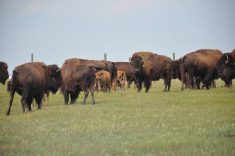Dr. Gerald Stokka of North Dakota State University says producers need to be aware of the different louse types and species.
“Sucking lice are vulnerable to systemic treatment such as avermectin products but the biting/chewing lice are not,” he says.
Producers used injectable and pour-on ivermectin for many years and got good lice control.
“But most parasites or bacteria evolve to evade control. I think we’ve entered a time where improper dose or natural resistance has allowed some lice to become less vulnerable to avermectin products,” says Stokka.
Read Also

Trump’s tariffs take their toll on U.S. producers
U.S. farmers say Trump’s tariffs have been devastating for growers in that country.
“We probably should not have used these for lice in the first place, especially as pour-ons because systemic absorption is highly variable, depending on dirt, moisture, hide thickness, hair follicles, etc. The injectable is more predictable because you are putting the drug under the skin to absorbed.”
Under-dosing leads to treatment failures.
“Producers assumed they still had 1,100 to 1,200-pound cows, whereas they now have 1,500 to 1,600-pound cows,” says Stokka.
“Another thing we did wrong was treat too early. We treat cattle at preg-check time because that’s when we have them in the chute. But most lice, especially biting lice, are not active when it’s warm. They need physical contact with the product. If they are not moving around, this won’t happen.
“My recommendation is to not treat for lice until you see a problem. By then you have cold weather and heightened lice activity, and treatment will be more successful. I also tell people to not use the avermectins for lice.”
Options are limited, however.
“We are basically down to two kinds of products: avermectins and pyrethrins. One pyrethrin product includes an egg-inhibitor, but you still won’t get much control if you apply it too early,” says Stokka.
“Producers have often overused delousing products. Some bulls being prepared for sale get poured for lice three times because the breeder wants them to look good and is trying to kill every louse. Soon the treatment is not very effective.
“I think we may eventually overuse our best products and reach a point where they don’t work anymore. We’ve already seen this happen with certain antibiotics and deworming products.”















